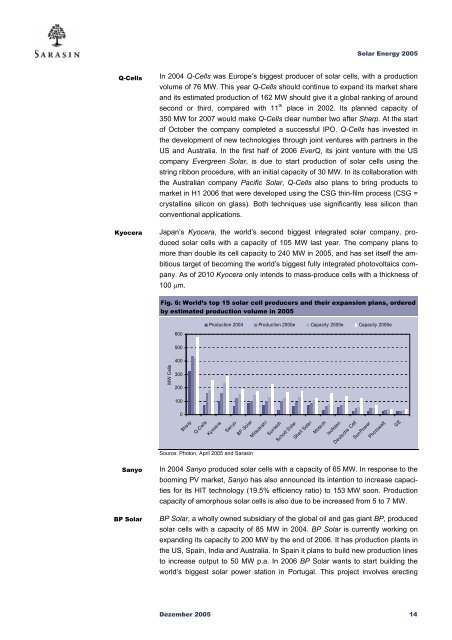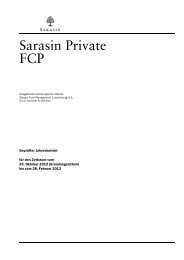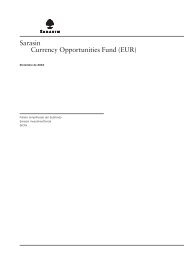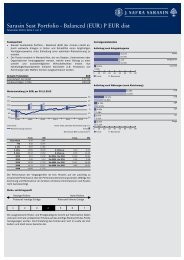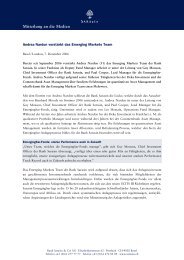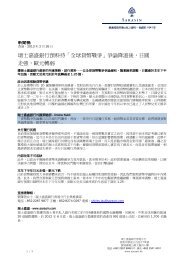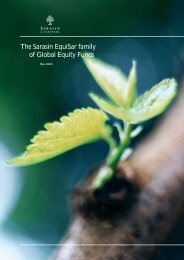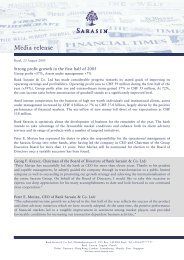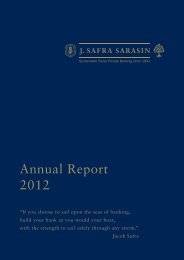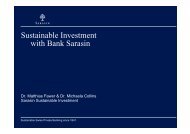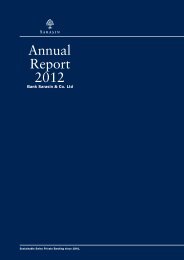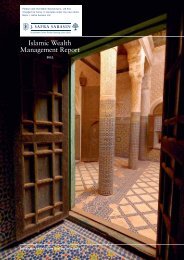Sustainability Report - Bank Sarasin-Alpen
Sustainability Report - Bank Sarasin-Alpen
Sustainability Report - Bank Sarasin-Alpen
Create successful ePaper yourself
Turn your PDF publications into a flip-book with our unique Google optimized e-Paper software.
Solar Energy 2005<br />
Q-Cells<br />
Kyocera<br />
In 2004 Q-Cells was Europe’s biggest producer of solar cells, with a production<br />
volume of 76 MW. This year Q-Cells should continue to expand its market share<br />
and its estimated production of 162 MW should give it a global ranking of around<br />
second or third, compared with 11 th place in 2002. Its planned capacity of<br />
350 MW for 2007 would make Q-Cells clear number two after Sharp. At the start<br />
of October the company completed a successful IPO. Q-Cells has invested in<br />
the development of new technologies through joint ventures with partners in the<br />
US and Australia. In the first half of 2006 EverQ, its joint venture with the US<br />
company Evergreen Solar, is due to start production of solar cells using the<br />
string ribbon procedure, with an initial capacity of 30 MW. In its collaboration with<br />
the Australian company Pacific Solar, Q-Cells also plans to bring products to<br />
market in H1 2006 that were developed using the CSG thin-film process (CSG =<br />
crystalline silicon on glass). Both techniques use significantly less silicon than<br />
conventional applications.<br />
Japan’s Kyocera, the world’s second biggest integrated solar company, produced<br />
solar cells with a capacity of 105 MW last year. The company plans to<br />
more than double its cell capacity to 240 MW in 2005, and has set itself the ambitious<br />
target of becoming the world’s biggest fully integrated photovoltaics company.<br />
As of 2010 Kyocera only intends to mass-produce cells with a thickness of<br />
100 µm.<br />
Fig. 6: World’s top 15 solar cell producers and their expansion plans, ordered<br />
by estimated production volume in 2005<br />
600<br />
Production 2004 Production 2005e Capacity 2005e Capacity 2006e<br />
500<br />
400<br />
MW Cells<br />
300<br />
200<br />
100<br />
0<br />
Sha rp<br />
Q-Cells<br />
Kyoce ra<br />
Sanyo<br />
BP Solar<br />
Mitsubishi<br />
Suntech<br />
Schott Solar<br />
Shell Solar<br />
Motech<br />
Isofoton<br />
Deutsche Cell<br />
SunPower<br />
Photowatt<br />
GE<br />
Source: Photon, April 2005 and <strong>Sarasin</strong><br />
Sanyo<br />
BP Solar<br />
In 2004 Sanyo produced solar cells with a capacity of 65 MW. In response to the<br />
booming PV market, Sanyo has also announced its intention to increase capacities<br />
for its HIT technology (19.5% efficiency ratio) to 153 MW soon. Production<br />
capacity of amorphous solar cells is also due to be increased from 5 to 7 MW.<br />
BP Solar, a wholly owned subsidiary of the global oil and gas giant BP, produced<br />
solar cells with a capacity of 85 MW in 2004. BP Solar is currently working on<br />
expanding its capacity to 200 MW by the end of 2006. It has production plants in<br />
the US, Spain, India and Australia. In Spain it plans to build new production lines<br />
to increase output to 50 MW p.a. In 2006 BP Solar wants to start building the<br />
world’s biggest solar power station in Portugal. This project involves erecting<br />
Dezember 2005 14


